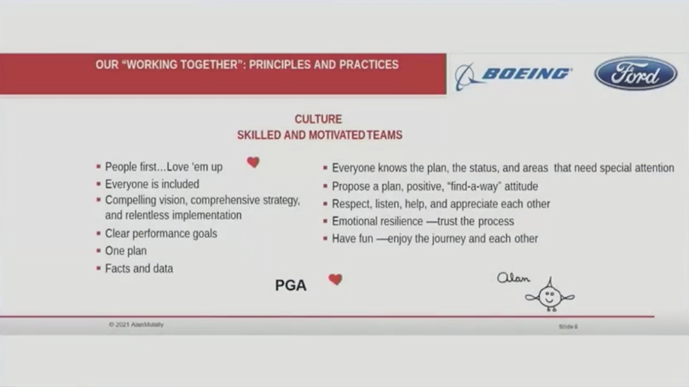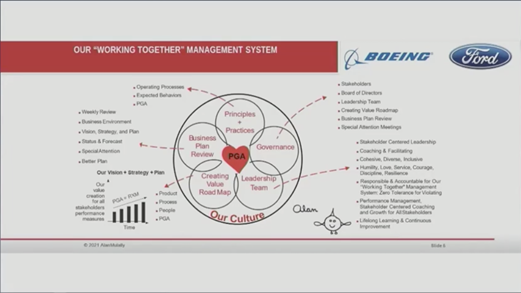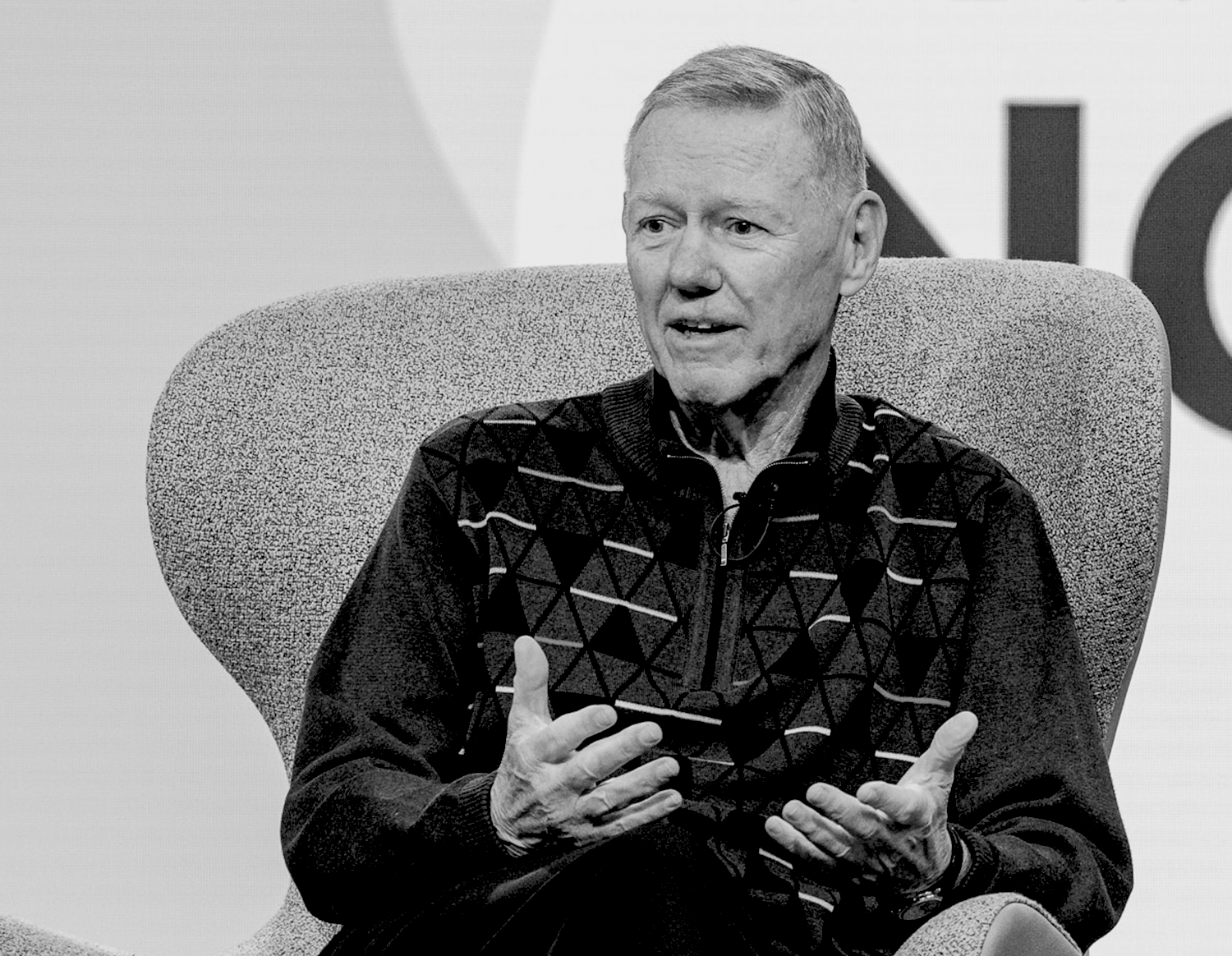In brief
- Alan Mulally’s “working together” principles and practices are credited with transforming Ford Motor Company from near-bankrupt relic to global powerhouse.
- His philosophy is centered around people, communication, and a clear vision for success.
- Under Mulally’s inspirational leadership, Ford became the number one brand in the U.S., enjoying soaring profits.
At the 2021 World Business Forum, Acertitude Co-Founder and Managing Partner, Kevin O’Neill, had the honor of meeting the legendary Alan Mulally. Mulally took part in a session where he shared his unique perspective on the challenges and practices of transformational change. His comments offer a roadmap for anyone who wants to learn from one of the most respected and inspirational CEOs of our times.
A roadmap for transformational change
How can you turn a troubled company around — not simply rescue it, but put it on the path to spectacular growth? That was the challenge Mulally faced when he became CEO of Ford Motor Company in 2006. An outsider in the close-knit world of autos, he entered a company that was locked into unfavorable union contracts, riven by in-fighting, and had just posted devastating losses of $12.7 billion. The company needed a compelling new vision, and fast.
Mulally started by rationalizing the number of brands, introducing a unified “One Ford” strategy of serving customers in all markets with a full family of vehicles. He saw Ford as a mobility company rather than simply an automaker, focusing on in-vehicle tech early on. His visionary strategy began to pay off, so much so that Ford was the only one of the “big three” auto firms who didn’t request a government bailout in the financial crisis. By the time Mulally’s plan was fully on track, Ford was the number one brand in the U.S., number two in Europe, and rapidly advancing in Asia. It was an amazing turnaround, cementing Mulally’s reputation as a miracle worker.
The reason that products at Boeing and Ford have been so successful is that we've always included all the stakeholders, not just the shareholders, so our suppliers, our customers, and the dealers, the airlines, the bankers, the investors.
Alan Mulally’s 11 essential principles and practices for success
Mulally credits his headline-grabbing success to his “Working Together Management System,” which he developed at Boeing and then sharpened at Ford:
- Put people first: Perhaps the most important principle is a focus on people. Not only do you need the contribution of your workforce, but also their enthusiasm and commitment. As Mulally said, “They’re talented, they’ve signed up to build a cathedral, so it’s important that they’re appreciated and treated with respect.”
- Include everyone: Involve all stakeholders — from suppliers and customers to workers and investors — giving them a reason to root for your success.
- Focus on vision, strategy, and implementation: Everyone needs to know what the vision is and how you’re going to implement it. “Not just the technical strategy, but the ‘work together’ strategy, the partnership strategy, the financing strategy,” said Mulally.
- Set clear performance goals for each part of your strategy.
- Have one plan that everyone follows right through the organization.
Work from the same data: One set of assumptions and facts helps you efficiently deal with crises or move innovations forward. - Ensure everyone knows what the plan is and how everything is progressing across multiple projects. Mulally favors a color-coded traffic-light system to keep tabs on projects.
- Have a positive, “find-a-way” attitude.
- Respect, listen, help, and appreciate: Create a culture that respects everyone’s contribution, no exceptions. As Mulally said, “If you hold people accountable, then everybody's values will start moving in a very positive direction.”
- Encourage emotional resilience: Have strategies for working together to overcome setbacks.
- Have fun: And make sure others can too by creating a safe environment for sharing data and ideas.

Include all the team, agree on your strategy, and then every week get together and every team member shares their part of it… and you look at the result, and you watch that cohesive team just come together.
Managing a powerful turnaround
Mulally’s deceptively simple management system implements these principles and practices to build accountability and collaboration. His approach starts right at the top, with governance. He feels that one of the most important elements is the role of the leadership team, which focuses on coaching rather than simply telling people what to do. Next comes a plan for creating long-term value. The ultimate goal is to create products and services and improve efficiency so that profits rise every year, along with other performance measures such as customer satisfaction.
Keeping it all on track
Regular meetings to review this roadmap, the business plan, and performance measures are crucial. “For the participants, sharing with them what’s really going on is the utmost respect you can show,” said Mulally. Following these meetings, “Everything that we look at is flowed throughout the organization, out through all of the shareholders, the stakeholders, and then the data is updated and flows all the way back up. Then we communicate it to everybody.” Ensuring people are always in the loop and reinforcing shared goals is something that’s very important to Mulally. It’s why when he joined Ford, employee engagement was less than 40%, but when he left eight years later, it had leapt to 92%. His collaborative approach – a far cry from the conflict and secrecy of earlier years — won hearts and minds right across a vast company, as well as in the boardroom.

From near-bankruptcy to astonishing growth
Mulally’s entire leadership philosophy is built on people, and what they can achieve when they work together. “The purpose of business is to create value…it's not just a financial thing because I would propose you're not going to be successful by just that financial measure,” he said. “You’d better have the employees, the investors, everybody along with you.”
What this meant for Ford was the kind of cultural change that took it from near-bankruptcy and over $30 billion in losses from 2006 to 2008, to a profit in 2009, followed by some of the most successful years in its history. This spectacular turnaround has made Mulally one of the most influential and revered CEOs in the business world. And his tried-and-tested management system could help your company too.
Never miss insights
Stay in the know with our thought leadership



